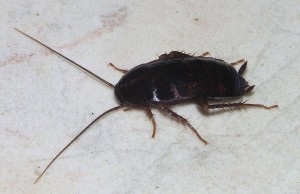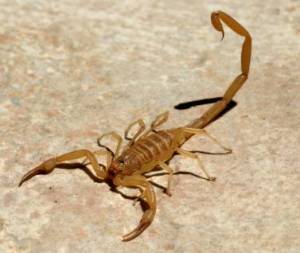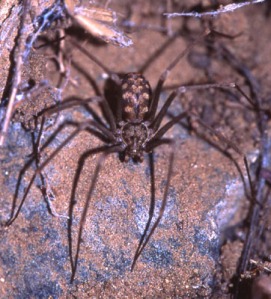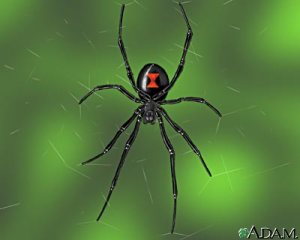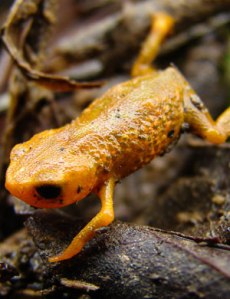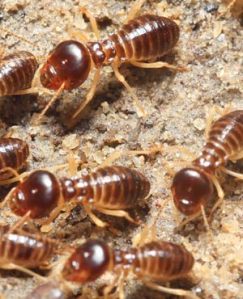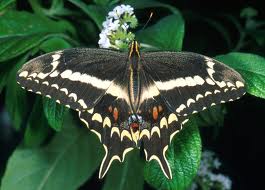Cockroaches can sense danger in sugar
Cockroaches will eat anything. Except sugar, that is.
Some of the common pests have evolved to learn how to detect and avoid a certain kind of glucose often used in bait traps, according to research published in the US journal Science on Thursday.
Scientists focused on the slender and small brown German cockroaches, which live all over the world in homes, offices and apartment buildings – anywhere humans tread and leave crumbs behind.
An apparent disdain for sweet-laced traps was first observed in some of these roaches in the early 1990s, about seven to eight years after commercial traps using glucose came on the market and entered into widespread use, said researcher Coby Schal of North Carolina State University.
The roaches were evolving quickly, scientists found. New generations were emerging that had inherited a genetic aversion to glucose.
And now, Schal says he and his colleagues understand why.
Glucose-averse roaches use their small taste-hairs to sample food first and if it contains glucose, they actually taste it as bitter, not sweet.
“They bounce back as if they got an electric shock. It is a very, very, very clear behaviour. They just absolutely refuse to ingest it,” said Schal, a professor of entomology.
“It is kind of like if you put something really bitter or really sour in your mouth and you immediately want to expel it.”
Filthy little creatures
Schal said this evolution came about “incredibly fast”, but noted that the development of antibiotic resistance in bacteria moves even faster.
It is hard to know what percentage of roaches have become averse to glucose. In this study, Schal and colleagues sampled various roaches from infestations in the United States, Russia, Puerto Rico and South Korea.
Of 19 populations studied, they found seven that contained glucose-averse roaches in their midst.
“This is a global phenomenon. It is not restricted to the US,” he said.
Professional exterminators have known about the issue for some time. The agrochemical industry has responded by altering baits to replace glucose with other attractants.
“We haven’t used any kind of trap that used sugar for years,” said Bob Kunst, president of Fischer Environmental, a pest control company in Louisiana.
Kunst, who was not involved in the study, described German cockroaches as “filthy little creatures” because they can carry salmonella.
Many of the major players in the pesticide industry keep their attractants under wraps for competitive purposes, but experts have a good idea of what works these days, he said.
“I would suggest certain high carbohydrate and base proteins are very popular with roaches,” Kunst said.
Roaches learn quickly
To illustrate how keen these newly evolved roaches are to survive and thrive without glucose, Schal and colleagues filmed the critters as they chose a fructose-based blob of jelly over one right next to it that contained glucose.
They also captured video of the roaches entirely avoiding a mound of jam containing glucose and flocking instead to a glob of peanut butter.
“We are showing that cockroaches can learn incredibly well. They can associate the punishment of tasting glucose with the smell of the bait.”
Schal said he hopes the agrochemical industry will take steps to more widely eliminate glucose from baits.
The German cockroach represents just one of about 5 000 species of roaches, and getting rid of the household pests all together would not be a bad thing, he said.
“As far as we know they do nothing for the ecological system outside of being pests in our homes, associated with us and possibly transmitting diseases and such,” he told AFP.
“In low-income housing it is a really severe problem. Cockroaches are responsible for a huge problem with allergic disease and asthma so it is really critically important to control them, to eliminate them.”
Other types of roaches in the world can be quite useful, from pollinating plants in the tropical rainforest to serving as a key food group for desert scorpions and shrews, he said.
– AFP
Scorpions behaviour
Scorpions are secretive creatures. Only when you know here to find them in an environment will you truly appreciate the population densities. They are often shy and reclusive that retreat to their shelters at the slightest disturbance. Scorpions are a good food source for many other animals. Because scorpion populations remain constant under normal conditions, they represent an available food source. Animals such as meercats, mongoose, owls, frogs, lizards, spiders and even other species of scorpions will readily prey on scorpions. Because of their stable populations, scorpions make a good indicator of the health of an environment.
They are often found in arid environments that other animals find difficult to survive in. Their success at inhabiting these environments is due to their behaviour more than their physical adaptation. Nocturnal tendencies mean that they are active during cooler times. Prey in the form of arthropods and small vertebrates are also active during these times so their activity patterns match those of their prey. Many desert living species live under the ground or at the base of vegetation. Burrows provide a microhabitat that is cooler and more humid than the surface during the day. Burrows also provide protection from predators.
Scorpions are opportunistic predators that will tackle just about anything small enough for them to overpower. Invertebrates for a large part of their diet but small lizards and mice may also be taken. Fellow scorpions may also form a large part of other more aggressive scorpion’s diet. The less aggressive scorpions however have adapted strategies at avoiding these more aggressive scorpions. Many for instance lie off the ground in vegetation where large species find it difficult to move in. Some are active under different environmental conditions than their aggressive relatives.
During the colder months when prey is not as available or when the ground is covered with snow, scorpions retreat to their shelters. During harsh conditions, scorpions can simply wait it out. When favourable conditions return, mass emergencies of scorpions may occur. This mass emergence after harsh conditions may give rise to plague proportions of scorpions. Their changing of behavioural patterns in response to environmental conditions makes them very successful animals in many parts of the world.
scorpion.co.za
Violin Spider
Name: The violin shaped marking on the carapace give these spiders their common name. In southern African species, this violin marking is not obvious.
Description: 8mm to 19mm in length. 6 eyes. Long legs. Cylindrical oval abdomen with a flattish carapace. These spiders can be yellowish, reddish brown or brown in colouration. The abdomen has dark chevron like markings. Unlike their name the violin shaped marking on the carapace is not always obvious in southern African species. The American Brown Recluse Spider, a relative of southern Africa species has an easily identifiable violin marking. Hence the name Violin Spider.
Distribution: Distributed throughout the subregion. May be common in some areas where they can be found under rocks, logs and just about any surface debris. In places like the Karroo, these spiders may be found behind pictures on walls inside farm houses.
Daddy Long Legs Spiders is often misidentified as a Violin Spider. They can be easily separated because Daddy Long Legs Spiders live almost exclusively in their webs. Violin spiders to not make webs.
Web: Most Violin Spiders construct a retreat using a characteristic bluish silk. Some cave living species construct a sheet web.
Venom: Highly cytotoxic venom. Initially, the bite is small and superficial looking. After a couple of hours swelling develops and the bite site becomes discoloured. Blistering occurs in the next few days after which the skin may peel away leaving a ulcerating wound. It’s important to stop secondary infection of setting in. If left untreated, tissue damage may be extensive. Bites from these spiders usually result in a permanent scarring. Bites usually occur at night when the victim is sleeping. There fangs are not large, hence the bite marks are close together.
Victims bitten by this spider should seek medical advice as soon as possible.
Notes: Nocturnal hunters, these spiders wander about actively seeking prey items. When resting, the often draw their legs up over their abdomen. When disturbed these spiders first lie still. If disturbed further they may run away in a jerky kind of way. Often found in pairs.
These spiders are shy in nature and bites in humans are very rare. Most spider bites in southern African are mistakenly attributed to Violin Spiders. These spiders do not bite many people and their bites are not as serious as internet email claim.
Rumors: There are emails doing the rounds that claim that because of the warm weather and good rains, Violin Spiders are reproducing by the thousands and entering houses. During the night these spiders creepy down and feed off humans biting them in the process. The email tells us to warn all children to watch out for these spiders.
Of course it’s all a load of hogwash. Violin spiders do occur in houses but not in great numbers. They are very venomous but very rarely bite people. You need to pull their legs off or stand on them before they will bite.
There is a reference to Cape Town in the emails which is strange since violin spiders are very rare in Cape Town. Once again the email contains no factual information whatsoever.
Spiders
Together with scorpions, spiders are probably the most recognizable of all arachnids. Spiders occur in almost every terrestrial habitat and even some aquatic habitats.
Everyone knows that spiders posses silk glands from which they spin silk. Spiders come in many different forms, from ant mimicking spiders to spiders that look like bird droppings. Some are communal, others solitary in their ways. Many spiders are very small indeed while others are huge.
All spiders except a single genera have venom glands (Feather Legged Spiders). Prey is captured using a vareity of techniques. Some spin webs to ensnare prey and others hunt down their prey. All spiders have silk glands which they use to construct webs, nests and egg sacs.
Courtship is often a very complex affair. Females lay eggs in egg sacs. Depending on the species, the female may guard her eggs after they are laid. Many hundreds of young may be produced. In some species, the female looks after the young spiderlings for the first part of their life.
Web Bound Spiders
Black Button Spider
Brown Button Spider
Daddy Long Legs Spider
Feather Legged Spider
Garbage Line Spider
Golden Orb Web Spider
Hermit Spider
Tropical Tent Spider
Free Living Spiders
Buck Spoor Spider
Flat Wall Spider
Golden Brown Baboon Spider
Horned Baboon Spider
Jumping Spider
Long Spinneretted Bark Spider
Rain Spider
Six Eyed Desert Crab Spider
Velvet Spider
Violin Spider
scorpions.co.za
Endangered SA frogs get luxury suite
The Pretoria zoo is going to start a breeding programme with 10 critically endangered Pickersgill’s Reed Frogs to help save them from extinction, Beeld reported on Friday.
A special “frog room” had been equipped for the six-month project, the zoo’s reptile expert Mike Adams told the newspaper
According to Beeld, the small, yellow-green frogs, are smaller than a man’s thumb and are endemic to South Africa, but are found in only 18 small habitats.
“Because they are so small, conservation has been difficult,” the newspaper quoted Adams as saying.
The Johannesburg Zoo had caught 40 of the frogs, of which 10 had been moved to Pretoria.
“No one knows at this point how to breed the frogs, so with these 10 we hope to write a breeding manual so that the programme can be replicated elsewhere,” Adams said.
Pretoria zoo spokesperson Angeline Schwan said amphibians were among the most endangered species on earth.
“There are about 7 000 species, of which 3 900 are threatened and 170 are apparently already extinct,” she said.
sapa
Frogs imported to California likely transmitted deadly fungal disease
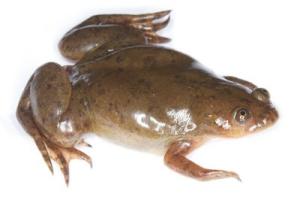
The African clawed frog was the subject of a Stanford/SFSU study that found that this species of frog was responsible for the decline or extinction of some 200 amphibian species worldwide. Brian Gatwicke/Stanford ( Brian Gatwicke )
Bay Area scientists believe they have discovered the Typhoid Mary of the frog world: a flat, feral creature that carried a deadly fungus from Africa to California’s ponds and puddles through global trading.
Genetic analysis revealed that eight of 206 African clawed frogs — caught wild or preserved in jars at the California Academy of Sciences — carried the fungal plague called chytridiomycosis, which leaves them unharmed but kills native frogs in catastrophic numbers.
An infection was detected in a frog captured in Africa in 1934, supporting the theory that the fungus thrived there before spreading worldwide. Another infected frog, still alive, was recently trapped in Golden Gate Park’s Lily Pond.
“It
The African clawed frog was the subject of a Stanford/SFSU study that found that this species of frog was responsible for the decline or extinction of some 200 amphibian species worldwide. Brian Gatwicke/Stanford ( Brian Gatwicke )
confirms our suspicions that this is one means of spread of the fungus into the environment, through frogs that were not native,” said Sherril Green, professor and chairwoman of comparative medicine at Stanford University, who collaborated on the study with San Francisco State biologist Vance Vredenburg.
The African clawed frog resembles roadkill, but it has served an important role in medicine and research. It was first brought to the United States for use as a pregnancy test in the early 20th century, when it was routinely injected with the urine of female patients. The frogs were useful because they ovulate when injected with human urine, produce eggs all year long, and were easily imported from Africa in large numbers.
Although
Advertisement
the practice is now discontinued, the African frogs likely were released into the environment by hospital workers, Green said. It was a well-intended gesture — with deadly consequences.
“Today, these frog populations are often found in or near urban areas,” said Vredenburg, associate professor of biology at San Francisco State. “It’s amazing that more than a half-century after being brought to California, these frogs are still here, and they still carry this highly infectious disease.”
The African frog may not be the only culprit. A University of Michigan study also has implicated bullfrogs, farmed as a food source in South America and shipped to America.
While the urban world and wild frogs have been at odds for a long time, the fungus is particularly tough on the thin-skinned creatures.
Called Batrachochytrium dendrobatidis, or “Bd,” it kills frogs by clogging their pores, deranging their blood chemistry and causing their tiny brains to swell.
The infection has led to the recent decline or extinction of 200 frog species worldwide, from the Sierra yellow-legged frog to the exotic jewel-colored creatures that decorate calendars, postage stamps and National Geographic magazine covers.
Some species seem resistant, such as the Bay Area’s common Pacific tree frog.
But scientists have not figured out a way to transfer such resiliency to vulnerable frogs. Vaccines, a routine type of human protection, are impractical.
To determine the African frogs’ role in the spread of the disease, Stanford and San Francisco State scientists and students spent hours in the basement of the California Academy of Sciences, sorting through thousands of specimen jars filled with old frogs floating in ethanol since 1871. Swabbing DNA from the skin between the toes and around the claws, they found that of 178 frogs, five (2.8 ercent) were positive for the fungus, confirming that the fungus was present among indigenous populations in Kenya and Uganda before they were exported worldwide.
They also embarked on frog-hunting expeditions. Traps — baited with supermarket chicken — caught 28 African clawed frogs, of which three (13 percent) tested positive. One lived in Golden Gate Park.
“It was a bit of forensic detective work,” Green said. The paper is published in Thursday’s issue of the journal PLOS ONE.
The timing of the epidemic’s spread fits with their theory, Green said. “It takes decades to see the effect of what an invading species does,” she said. “We are beginning to see now what happened long ago.”
Because the frogs are widely dispersed across the globe, Green and Vredenburg said containing the epidemic is a major challenge. The well-established fungus also can spread through water, wind and feathers of birds, Green said.
The frogs’ use, sale and transport are now highly regulated in California, but the damage has been done, they said. (A pygmy version, a favorite of aquarium enthusiasts, is less hardy, so it’s not considered a threat.)
“Now we need to be cautious about other introduced species,” Vredenburg said. “There could be other animals out there that are carrying diseases that we don’t even know about yet.”
MercuryNews.com
Climate change to hit plants, animals
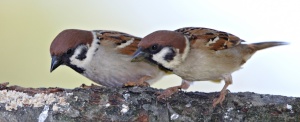
Climate change is likely to have a significant impact on plant and animal species, a study has found
More than half of common species of plants and a third of animal species are likely to see their living space halved by 2080 on current trends of carbon emissions, a climate study said on Sunday.
Output of man-made greenhouse gases is putting Earth on track for 4°C of warming by 2100 compared with the pre-industrial 18th century, it said.
The unprecedented speed of warming will be a shock for many species, as it will badly affect the climatic range in which they can live, it warned.
Investigators from Britain’s University of East Anglia looked at 48 786 species and measured how their range would be affected according to models of carbon dioxide (CO2) emissions.
Fifty-five percent of plants and 35% of animals could see their living space halved by 2080 at current emission growth for CO2, they found. The figures take into account the species’ ability to migrate into habitat that may open up as a result of warming.
Symptoms
The species most at risk are amphibians, as well as plants and reptiles, and regions that would lose most are Sub-Saharan Africa, Central America, Amazonia and Australia, the paper said.
Lead researcher Rachel Warren said the estimates “are probably conservative” as they were based only on the impact of rising global temperatures.
Other symptoms of climate change – storms, droughts, floods and pests, for instance – would amplify the problem.
“Animals in particular may decline more as our predictions will be compounded by a loss of food from plants,” Warren said in a press release.
“There will also be a knock-on effect for humans because these species are important for things like water and air purification, flood control, nutrient cycling and eco-tourism.”
The study, published in Nature Climate Change, said there was a ray of light.
If carbon emissions peak in 2016 – and decline by 3% to 4% annually thereafter – this would limit 2100 warming to 2°C, avoiding around 60% of the projected impact from business-as-usual emissions.
Negotiations
But if the peak is delayed until 2021, emissions would have fall yearly by 6% to achieve 2°C warming, which would need a costlier effort to rein in energy use.
Alternatively, if emissions peak by 2030 and then are reduced at 5% annually to limit warming to around 2.8°C, the loss of climatic range would be reduced by 40% compared with business-as usual.
UN members have adopted the 2°C target in world climate talks, which aim to conclude a new treaty on carbon emissions by 2015 and have it ratified by 2020.
But the negotiations have been making poor progress, and the yearly rise in emissions, driven especially by the burning of coal in big developing countries, has led many scientists to conclude that warming of 3°C or 4°C is probable by century’s end.
The new study says that loss of climate range would be bound to boost the risk of species extinction.
The Nobel-winning Intergovernmental Panel on Climate Change (IPCC) has estimated that 20% – 30% of species would be at increasingly high risk of extinction if warming exceeds 2°C or 3°C above pre-industrial levels.
AFP
Eating insects could help fight fat
The thought of eating beetles, caterpillars and ants may give you the creeps, but the authors of a UN report published on Monday said the health benefits of consuming nutritious insects could help fight obesity.
More than 1 900 species of insects are eaten around the world, mainly in Africa and Asia, but people in the West generally turn their noses up at the likes of grasshoppers, termites and other crunchy fare.
The authors of the study by the forestry department, part of the UN food and agriculture organisation (FAO), said many insects contained the same amount of protein and minerals as meat and more healthy fats doctors recommend in balanced diets.
“In the West we have a cultural bias, and think that because insects come from developing countries, they cannot be good,” said scientist Arnold van Huis from Wageningen University in the Netherlands, one of the authors of the report.
Eva Muller of the FAO said restaurants in Europe were starting to offer insect-based dishes, presenting them to diners as exotic delicacies.
Danish restaurant Noma, for example, crowned the world’s best for three years running in one poll, is renowned for ingredients including ants and fermented grasshoppers.
As well as helping in the costly battle against obesity, which the World Health Organisation estimates has nearly doubled since 1980 and affects around 500 million people, the report said insect farming was likely to be less land-dependent than traditional livestock and produce fewer greenhouse gases.
It would also provide business and export opportunities for poor people in developing countries, especially women, who are often responsible for collecting insects in rural communities.
Van Huis said barriers to enjoying dishes such as bee larvae yoghurt were psychological – in a blind test carried out by his team, nine out of 10 people preferred meatballs made from roughly half meat and half mealworms to those made from meat.
– Reuters
Three Florida butterfly specis vanish
After six years of searching, an entomologist has concluded that three varieties of butterflies native to south Florida have become extinct, nearly doubling the number of North American butterflies known to be gone.
“These are unique butterflies to Florida. This is our biological treasure. Each unique species that we lose, we won’t ever get that back again,” Marc Minno, who conducted the survey for the US Fish and Wildlife Service and the Florida Keys Mosquito Control District, said on Monday.
The disappearance of butterflies should serve as a warning about the degradation of south Florida’s environment, he said.
“It’s indicating there are major problems, environmental harm to Florida. And this is an indication that quality for people is also degrading and people should be worried about that,” Minno said.
Before Minno’s survey, only four varieties of North American butterflies, all from California, were presumed to be extinct, and the last one added to the list was 55 years ago.
Besides the three varieties which Minno concluded are extinct, two more native butterflies no longer exist in Florida but are living in the Caribbean, and two more are heading toward extinction, he said.
What is happening to the Florida butterflies remains an unanswered question
“The Schaus’ Swallowtail, found only in the upper Florida Keys, became in 1976 one of the first insects ever given legal protection under the federal Endangered Species Act.”
Minno said only six of the swallowtails were sighted in 2012.
Scientists began noticing a general decline in the butterfly populations in the 1980s, and Minno, like many scientists, assumed the spraying of pesticides to kill mosquitoes might be at fault. But his survey suggested otherwise.
In urban areas, such as Key West which has little natural habitat remaining and is routinely sprayed, Minno said: “There are so many butterflies flying you can hardly keep track of them all. There are just swarms of butterflies sometimes. You just wonder what the heck is going on. It’s just the opposite of what you would think.”
By contrast, Minno said he found few butterflies in vast conservations lands without mosquito control, such as the million-acre Everglades National Park and Biscayne National Park.
One of his theories is that mosquito spraying might bolster butterfly populations by killing off native and non-native parasitic wasps which feast on butterfly larvae and caterpillars.
Another theory is that invasive predatory ants, such as the Mexican twig ant and fire ants, which were introduced to the area in the 1970s and are unrestrained by pesticides in conservation areas, might be overwhelming butterfly populations there.
Minno said the three butterflies that were found only in southern Florida and are now extinct are the Florida Zestos Skipper, the Rockland Meske’s Skipper, and the Keys Zarucco Skipper.
In addition, the Bahamian Swallowtails and the Nickerbean Blues are gone from Florida but alive in the Caribbean.
Minno also expects the Schaus’ Swallowtail and the Miami Blue, both of which continue to decline despite formal recovery plans, to become extinct soon.
Of 120 varieties of butterflies documented in the Keys, Minno said 18 have become imperiled since the 1970s.
Minno said no state, federal or private agency has funded research to find out what is causing the decline.
Reuters

